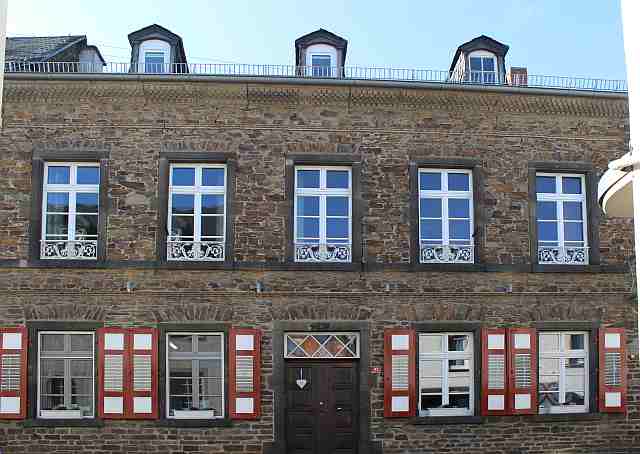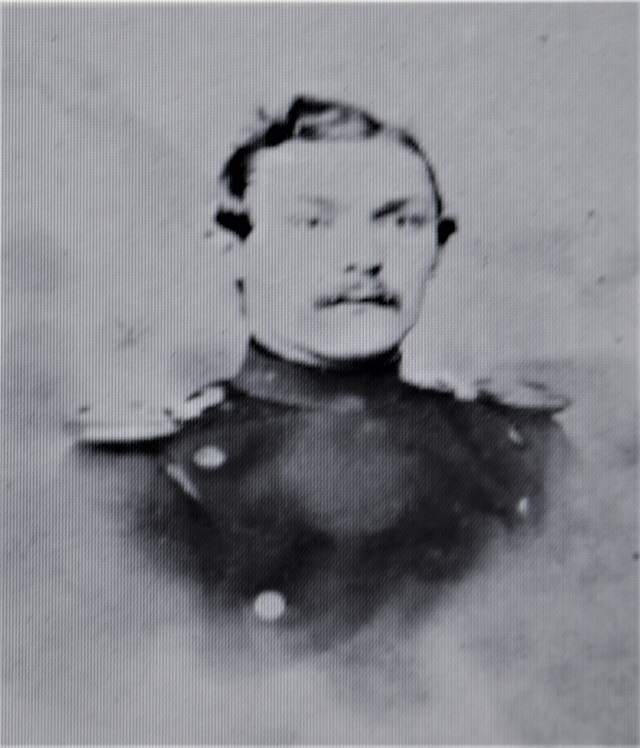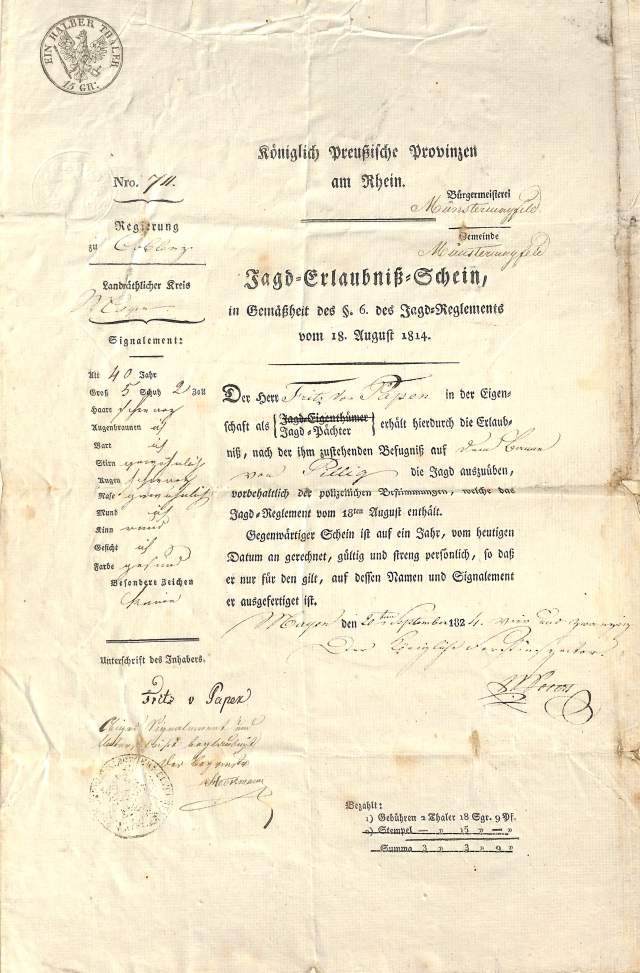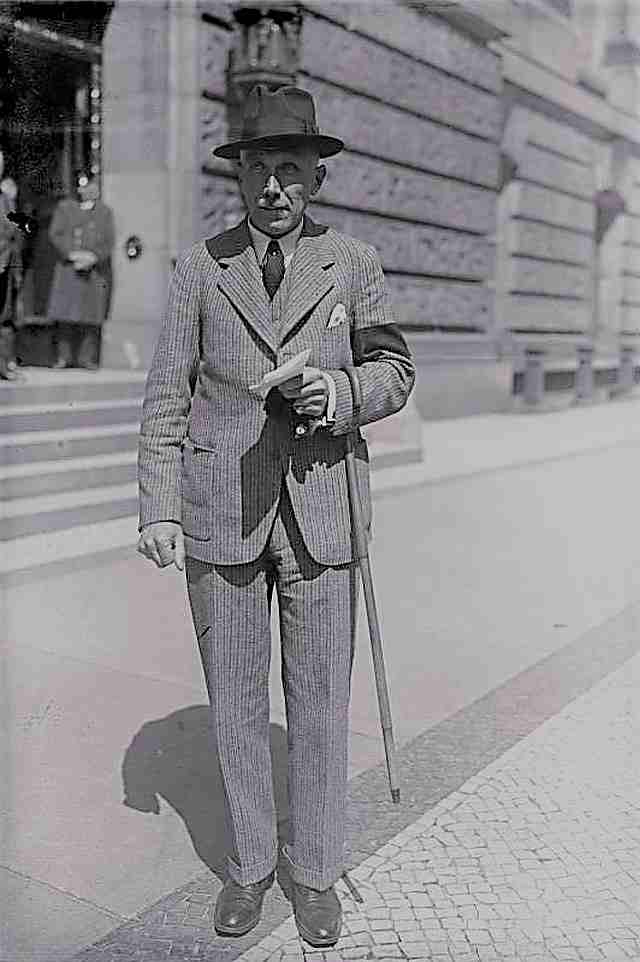11. Von Papen House
Built between 1834-1842
The client was Baron Ferdinand von Papen.
The Chancellor of the Reich Franz von
Papen (1932) was a great-nephew
of the builder.
Baron Ferdinand von Papen (1811-1863) came to Münstermaifeld from Werl in 1833. The baron could enjoy his social position as an estate owner in the representative building, demonstrating that he was an esteemed citizen. When he passed away in 1863, of the 11 children, Carl Ferdinand took over the house. Due to a divorce in 1875, he lost his house and his future in Münstermaifeld. No member of the family von Papen remained in the city. The Reich Chancellor von Papen, who entered history as the “stirrup holder of Hitler", is a great-nephew of the builder of the house.
The hous at Obertorstraße 42 is one of the first residential buildings to be erected outside the demolished city wall.

With the demolition of the town wall, Obertorstraße became a preferred building area. Unlike the houses usually built in Münstermaifeld in the 19th century, the building was not made of brick, but of rubble stone. It was probably planned by the Koblenz master builder Ferdinand Nebel and built between 1834 and 1842.
Baron Ferdinand von Papen, the builder, was born in Werl (Westphalia) on 7 August 1811.

The von Papen family had acquired wealth and nobility in Werl as holders of a privilege to extract salt (Erbsälzer). Their coat of arms motto "Si deus pro nobis, quis contra nos" bears witness to their self-image. Ferdinand von Papen came to Münstermaifeld in 1833. He had already made the acquaintance of the Maifeld before. His father, Friedrich Leopold, was married to Margarete Walpurga von Heddesdorff. She was an aunt of Hyazinthe von Heddesdorff, the second wife of Franz Georg Severus Weckbecker. The barons of Heddesdorff were propertied in Winningen. Friedrich Leopold, like his son Ferdinand, was a passionate hunter. In 1824, his hunting permit for the municipal area of Pillig was authenticated in Münstermaifeld.


Ferdinand had married Gertrudis Weckbecker, a niece of Franz Georg Severus Weckbecker, in 1832. His brother Franz Joseph was the grandfather of the Reich Chancellor Franz von Papen.
When Ferdinand died on 22 September 1863, he was a respected man. He had 11 children born between 1833 and 1849. His wife's cousin, Peter Weckbecker mentions in his autobiography that the family was "more blessed with children than with temporal goods". From 1850-1862, Ferdinand was captain of the St. Sebastianus Schützenbruderschaft. Three times he was also crowned Schützenkönig. It is fitting that he killed the last wolf in the Mayen district in 1853. His name became known beyond the Maifeld in 1842 in connection with the defamation scandal surrounding Dr. Rath, a doctor practising in Münstermaifeld. Dr. Rathhe was suspected of having planned an assassination attempt on Napoleon's grandnephew, Alfred Bonaparte. Baron von Papen was cited in the press with other notables of the city as a witness in this alleged murder plot. He denied this in a letter to the editor of the "Neue Rheinische Zeitung". His son Carl Ferdinand, the von Papen family heir after the death of the elder brothers, inherited the house in Obertorstraße. On 10 October 1865, Carl Ferdinand married Anna Amalia Antonia Thonet from the family of furniture manufacturers, made famous by the "Viennese coffee house chair". After the death of his wife in 1871, he married again in 1873. But the second marriage failed as early as 1875, and the divorce brought him ruin.
The von Papens left Münstermaifeld. Carl Ferdinand died in Reutlingen on 12 May 1896. Since 1878, a tavern had been run in the house by Anton Marx and his wife Elisabeth. As the last inn at the exit of the town, they could count on lively visitors from the surrounding area. When an extension of the licence was applied for in 1902, the mayor advised the district administrator against it. "In Münstermaifeld there are 15 inns, 4 small liquor stores and 6 bottled beer stores. In the Obertorstraße alone, apart from the inn run by Anton Marx, there are another 7 inns and there is no need for this inn to continue operating". Despite this refusal, the concession was extended.
From 1993 to 2005, the Hansen Maronette Theatre performed in the barn of the property. Since 2009, the house has again been used for gastronomy.
The Reich Chancellor Franz von Papen (1879-1969), a grandnephew of Ferdinand von Papen, has gone down in the history books as Hitler's "stirrup holder".

His term of office ended as early as December 1932. He was then Vice-Chancellor in Hitler's cabinet from January 1933 to July 1934. He was subsequently ambassador to Vienna until 1938, then ambassador to Ankara until 1944. After an acquittal at the Nuremberg Trials in 1946, he was sentenced to 8 years in a labour camp as the main culprit in a Spruchkammer trial. He was released in 1949.
Glossar
Napleon Alfred Bonaparte-Wyse
Baron von Papen and Münstermaifeld came to the attention of the press in Germany and beyond in 1842. In the winter of 1838/39, the doctor Dr. Rath had a patient, or as it was claimed, a prisoner, in his house in Müstermaifeld who was famous because of his origins. It was Napoleon's great-nephew, Napleon Alfred Bonaparte-Wyse. As the prisoner of Dr. Roos, who was to hold and even murder Napoleon Alfred, the writer Victor d'Arlincourt makes him known to the readers of Europe in his novel Le Pèlerin. The writer cited prominent citizens of Münstermaifeld as witnesses to the intended murder plot. At the top were Baron von Papen, Weckbecker, Canaris, von Heddesdorff and Justice of the Peace Nachtsheim. The aforementioned had sought the proximity of the famous name, invited him to dinner, accompanied him on walks. After the publication of Victor d'Arlincourt's work, the witnesses found themselves in the midst of a libel suit and a press scandal. The writer had used their positive impressions of the young Napoleon Alfred as evidence to support his story of an assassination attempt. In truth, Naopleon's great-nephew was mentally disturbed and Dr Rath was to help cure him. The doctor was rehabilitated in the end, the so-called witnesses had to distance themselves from the slander of Dr. Rath partly with letters to the editor of Karl Marx's Neue Rheinische Zeitung.
Ferdinand Nebel
He was an architect and, from 1823, a Prussian land building inspector. Like his son Hermann, who was an architect and Koblenz city architect, he left behind numerous public buildings in the Koblenz area. Father and son Nebel introduced the process of manufacturing lightweight building blocks from pumice to the market.



